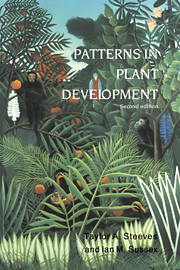Book contents
- Frontmatter
- Contents
- Preface
- Acknowledgments
- 1 Development in the vascular plants
- 2 Embryogenesis: beginnings of development
- 3 Analytical and experimental studies of embryo development
- 4 The structure of the shoot apex
- 5 Analytical studies of the shoot apex
- 6 Experimental investigations on the shoot apex
- 7 Organogenesis in the shoot: leaf origin and position
- 8 Organogenesis in the shoot: determination of leaves and branches
- 9 Organogenesis in the shoot: later stages of leaf development
- 10 Determinate shoots: thorns and flowers
- 11 The development of the shoot system
- 12 The root
- 13 Differentiation of the plant body: the origin of pattern
- 14 Differentiation of the plant body: the elaboration of pattern
- 15 Secondary growth: the vascular cambium
- 16 Secondary growth: experimental studies on the cambium
- 17 Alternative patterns of development
- Credits
- Author index
- Subject index
12 - The root
Published online by Cambridge University Press: 21 December 2009
- Frontmatter
- Contents
- Preface
- Acknowledgments
- 1 Development in the vascular plants
- 2 Embryogenesis: beginnings of development
- 3 Analytical and experimental studies of embryo development
- 4 The structure of the shoot apex
- 5 Analytical studies of the shoot apex
- 6 Experimental investigations on the shoot apex
- 7 Organogenesis in the shoot: leaf origin and position
- 8 Organogenesis in the shoot: determination of leaves and branches
- 9 Organogenesis in the shoot: later stages of leaf development
- 10 Determinate shoots: thorns and flowers
- 11 The development of the shoot system
- 12 The root
- 13 Differentiation of the plant body: the origin of pattern
- 14 Differentiation of the plant body: the elaboration of pattern
- 15 Secondary growth: the vascular cambium
- 16 Secondary growth: experimental studies on the cambium
- 17 Alternative patterns of development
- Credits
- Author index
- Subject index
Summary
The previous eight chapters have dealt with postembryonic development of the shoot. Consideration must now be given to the subsequent development of the other meristem initiated in the embryo, the root apical meristem. The organ system that develops from this meristem during the ontogeny of the plant is as extensive as the shoot system and in many cases exceeds the aerial system in size. Moreover, root systems show considerable morphological diversity and are by no means stereotyped in form or in development. Unfortunately, however, this is not generally appreciated because root systems are inaccessible to direct and sequential observation of the type that can easily be made on the shoot. Without elaborate excavation, root systems cannot be studied except in special cases, and even when exposed, they can hardly be observed ontogenetically in anything approaching normal circumstances. It is, therefore, regrettable, but not surprising, that much of our knowledge of root development is based upon laboratory-cultured seedlings of annual crop plants.
The remarkable extent of certain individual root systems has been revealed by excavation and measurement. Ecologists have long recognized that in a plant community there is usually a stratification of root systems comparable to the multiple stories of shoots. Such a layering tends to minimize competition among species for water and nutrients in the soil, and it has been shown to have an important bearing upon survival under adverse conditions.
- Type
- Chapter
- Information
- Patterns in Plant Development , pp. 229 - 254Publisher: Cambridge University PressPrint publication year: 1989
- 1
- Cited by

